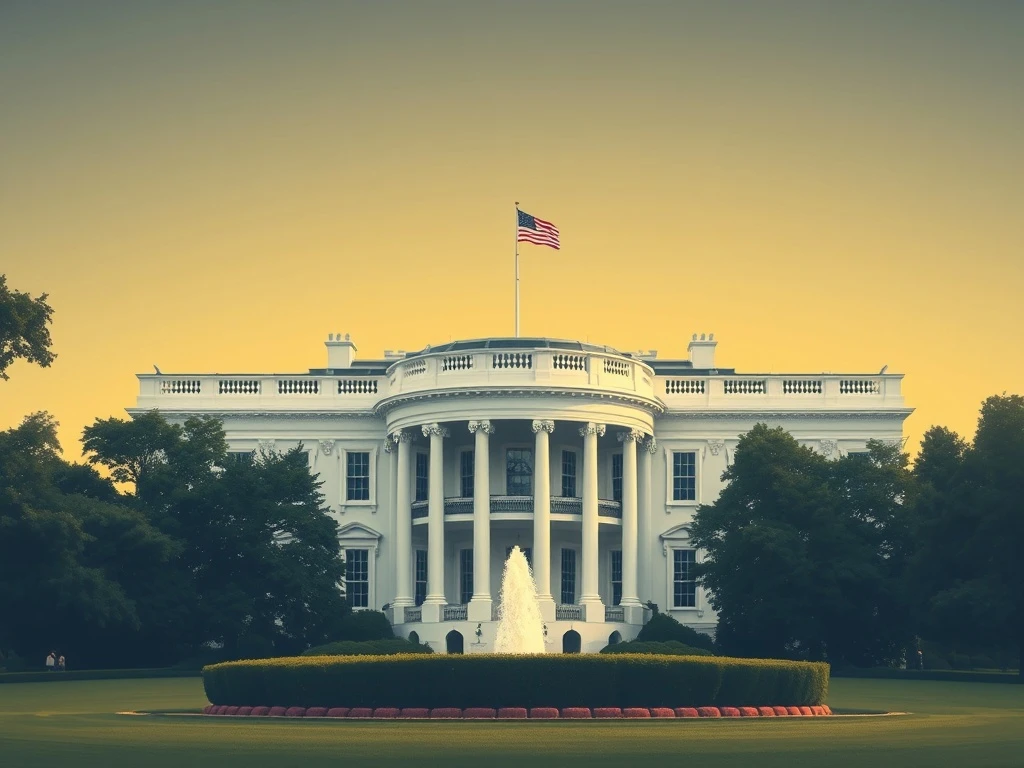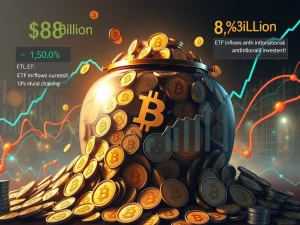Unlocking the Future: White House Unveils Game-Changing Crypto Policy on July 30, Featuring Bitcoin Reserve & Fed Access

Get ready for a seismic shift in the world of cryptocurrency! Bitcoin News today is buzzing with anticipation as the White House prepares to unveil its long-awaited comprehensive crypto policy report on July 30. This isn’t just another government document; it’s poised to redefine the United States’ stance on digital assets, potentially reshaping the global financial landscape. For anyone invested in the future of decentralized finance, this report is a must-watch event.
The Grand Unveiling: White House Crypto Policy Takes Center Stage
The upcoming White House Crypto Policy report, spearheaded by Executive Director of the President’s Digital Asset Advisory Council, Bo Hines, and tech entrepreneur David Sacks, is the culmination of a rigorous 180-day review. This extensive effort involved the President’s Working Group on Digital Assets, a cross-agency collaboration featuring key departments like the Treasury, SEC, CFTC, and Commerce. The sheer breadth of involvement underscores the administration’s serious commitment to tackling the complexities of the digital asset sector.
The report aims to cement U.S. dominance in digital finance. While details are still emerging, early insights suggest groundbreaking proposals. These include the potential creation of a Bitcoin Reserve and expanded access to the Federal Reserve’s payment systems for blockchain firms. Such initiatives signal a proactive approach to integrating cryptocurrencies into the mainstream financial system, rather than merely reacting to their growth.
A Bold Move: Exploring the Bitcoin Reserve Concept
Perhaps the most radical proposal expected in the report is the concept of a Bitcoin Reserve. This initiative explores leveraging government-held or seized Bitcoin to hedge against dollar volatility, all while preserving liquidity. It’s a fascinating idea that mirrors strategies seen in the corporate world and even at the national level, such as El Salvador’s adoption of Bitcoin as legal tender. However, the U.S. approach would undoubtedly come with far stricter compliance measures and regulatory oversight.
The specifics of how such a reserve would function remain a key question. Would the government actively trade these reserves, much like a central bank manages foreign currency reserves, or would they be held long-term as a strategic asset? The answers to these questions will have significant implications for market stability and the perception of Bitcoin as a legitimate treasury asset. The idea alone, however, marks a significant philosophical shift in traditional financial thinking.
Opening Doors: Fed Access for Digital Asset Firms
Another pivotal aspect of the upcoming policy is the proposal to grant Fed Access directly to the Federal Reserve’s payment infrastructure for digital asset firms. This move could be a game-changer, potentially streamlining transactions and dramatically increasing the efficiency of crypto-related businesses. By allowing direct access, the report aims to reduce reliance on traditional banking intermediaries, which could foster intense competition within the financial sector.
However, this expanded access is not without its caveats. It’s highly probable that such privileges would be contingent on stringent capital requirements and robust auditing standards. While this would ensure financial stability and mitigate risks, it could also create a barrier to entry for smaller, emerging firms, potentially favoring established players with the resources to meet these demanding criteria. The goal is to integrate, but with caution.
Stablecoins vs. CBDCs: The Administration’s Stance
The report is also expected to clarify the administration’s preferred path for digital currencies, advocating strongly for dollar-backed, privately issued stablecoins over central bank digital currencies (CBDCs). This stance reflects a cautious approach to centralized control, emphasizing privacy concerns and the potential risks associated with government-controlled digital money. The preference for private stablecoins suggests a desire to leverage private sector innovation while maintaining the stability and global dominance of the U.S. dollar.
This position is significant as it pushes back against the trend seen in some other nations exploring CBDCs. By favoring private stablecoins, the U.S. aims to encourage a competitive market while ensuring that these digital assets are securely backed and regulated, without creating a new, potentially intrusive, government-issued currency.
Navigating the Regulatory Maze: Challenges Ahead for Digital Assets
One of the persistent headaches for the crypto industry has been the ongoing jurisdictional disputes between the SEC and CFTC. These agencies have long debated whether most tokens should be classified as securities or commodities, leading to regulatory uncertainty. The working group’s proposed solution—a bifurcated oversight framework based on asset functionality—aims to bring clarity. However, it may not fully satisfy either side, highlighting the report’s limited capacity to resolve these deep-seated conflicts entirely.
The success of the new framework will depend on its ability to provide clear guidelines that foster innovation without compromising investor protection. The challenge lies in creating a system that is adaptable enough for the rapidly evolving world of digital assets, yet firm enough to prevent illicit activities and market manipulation.
The Political Landscape and Future of Digital Assets
The political context adds another layer of complexity to the report’s trajectory. A potential Trump administration, for instance, has signaled support for minimizing regulatory barriers, which could further accelerate institutional crypto adoption. Initiatives like the Web3 banking alliance between WLFI and Vaulta underscore this growing trend, aligning with broader calls for regulatory clarity.
Furthermore, entities backed by prominent political figures, such as Trump Media & Technology Group, have made substantial Bitcoin investments. This signals a fascinating convergence of political and market forces, suggesting that the adoption of digital assets is becoming a bipartisan issue. The report’s immediate impact will hinge on its ability to strike a delicate balance between incentivizing innovation and ensuring financial stability and consumer protection.
Global Implications and US Leadership in Digital Assets
As the U.S. positions itself in a rapidly evolving global digital asset landscape, the White House’s approach could set significant precedents for cross-border cooperation. Recent U.S.-Japan trade agreements and reduced EU import tariffs hint at shifting economic diplomacy, though the U.S. stance on centralized versus decentralized frameworks remains a point of global interest.
The report’s recommendations on stablecoin governance, institutional participation, and infrastructure will be critical, especially given the sector’s impressive $260 billion market size and expanding influence. The global community will be watching closely to see how the U.S. balances its desire for leadership with the need for international collaboration in this interconnected digital economy.
Conclusion: A Defining Moment for US Crypto Policy
The July 30 release of the White House’s comprehensive crypto policy report marks a truly pivotal moment in U.S. crypto policy. By addressing critical infrastructure gaps, striving for regulatory alignment, and aiming to bolster international collaboration, the report endeavors to solidify American leadership in the burgeoning digital financial ecosystem. However, the true measure of its success will lie in its ability to translate ambitious proposals into actionable, effective policies that can skillfully navigate the intricate political, regulatory, and market dynamics that have historically defined the sector’s evolution. This report isn’t just about rules; it’s about shaping the future of finance itself.
Frequently Asked Questions (FAQs)
Q1: What is the main focus of the White House’s new crypto policy report?
The report focuses on redefining the U.S. approach to digital assets, with key proposals including the potential creation of a Bitcoin reserve, expanded Federal Reserve access for blockchain firms, and strategies to maintain U.S. leadership in global digital finance.
Q2: What is the significance of a potential Bitcoin Reserve?
A Bitcoin Reserve could allow the U.S. government to leverage seized or held Bitcoin to hedge against dollar volatility and preserve liquidity. It represents a radical shift from traditional treasury practices and acknowledges Bitcoin’s growing role as a strategic asset.
Q3: How would direct Fed Access benefit digital asset firms?
Granting digital asset firms direct access to the Federal Reserve’s payment infrastructure could streamline transactions, reduce reliance on traditional banks, and intensify competition within the financial sector, leading to greater efficiency for crypto businesses.
Q4: What is the White House’s stance on stablecoins versus CBDCs?
The report is expected to advocate for dollar-backed, privately issued stablecoins over central bank digital currencies (CBDCs). This preference emphasizes privacy concerns and aims to leverage private sector innovation while maintaining the stability of the U.S. dollar.
Q5: What regulatory challenges does the report address?
The report attempts to navigate ongoing jurisdictional disputes between the SEC and CFTC, proposing a bifurcated oversight framework based on asset functionality. However, it acknowledges the difficulty in fully resolving these deep-seated conflicts.
Q6: How might political factors influence the implementation of this policy?
Political factors, such as a potential Trump administration’s support for minimizing regulatory barriers and growing institutional crypto adoption (e.g., Trump Media’s Bitcoin investments), could influence the policy’s trajectory, potentially prioritizing innovation while still balancing investor protection.








